Book/Article Reviews
Islamic Wine-Goblets and Christian Adultery
Wine and the nectar of the beloved’s mouth entail no sin or crime
Except for heretics who have swerved from our (rightful) creed.
— Ibn Rāfi’ Ra’sah (early Islamic poet; quoted in J. A. Abu-Haidar, “The Muwashshahāt and the Kharjas Tell their Own Story,” p. 57; Al-Qantara 26.1 (2005): 43-98)
Avicenna was fond of wine, and, on being reproached for his defiance of the Koran, replied: “Wine is forbidden because it excites quarrels and bad passions, but I, being preserved from excesses by my philosophy, drink wine to sharpen my wits.”
— George Henry Lewes, The History of Philosophy From Thales to Comte, vol. 2 (1867)
The Mahommedan and Christian Arabs of Asyut get on admirably together. They smile at the mistaken (as they suppose) opinions of each other; and the educated Arab smiles at both. But there is no intolerance, no ill-will, no anathematising. I remember offering a glass of wine to an Arab at Tunis, chiefly with the mischievous object of seeing how he would refuse it. Quaffing it off, to my surprise, he drank my health. “I thought,” said I, “that wine was forbidden by your religion?” “Drunkenness, not drink, is what is meant,” he replied with a smile.
— Wordsworth Donisthorpe [yes, that Wordsworth Donisthorpe], Down the Stream of Civilization (1898)
Some years ago, I attended a dinner at Princeton University where I witnessed a revealing exchange between an eminent European philosopher who was visiting from Cambridge, and a Muslim scholar who was seated next to him. The Muslim colleague was indulging in a glass of wine. Evidently troubled by this, the distinguished don eventually asked his dining companion if he might be so bold as to venture a personal question. “Do you consider yourself a Muslim?” “Yes,” came the reply. “How come, then, you are drinking wine?” The Muslim colleague smiled gently. “My family have been Muslims for a thousand years,” he said, “during which time we have always been drinking wine.” An expression of distress appeared on the learned logician’s pale countenance, prompting the further clarification: “You see, we are Muslim wine-drinkers.”
— Shahab Ahmed, What Is Islam? The Importance of Being Islamic (2015)
That of which a large amount intoxicates, a small amount is forbidden.
— The Prophet Muhammad, Hadith, quoted in Ahmed, op. cit.
Reference to an ‘Islamic wine goblet’ makes about as much sense as talk of ‘Christian adultery.’
— Thomas Bauer, quoted in Ahmed, op. cit.
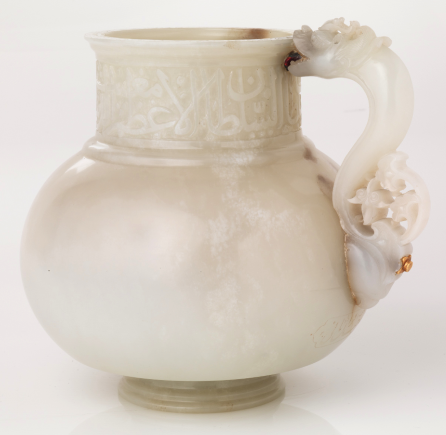
Islamic wine goblet (Uzbekistan, 15th century)
Drink Wine and Look at the Moon
I recently finished reading What Is Islam? (available on Amazon here, and free to read online or download here) by the late Shahab Ahmed (note: not to be confused with the Australian murderer of the same name!). I wasn’t convinced by all of it, or by the author’s slightly postmodern frame of reference (while Ahmed pokes fun, in a footnote, at another scholar’s prose style as “unnecessarily complicated and none-too-transparent,” I fear the same charge could be brought against much of Ahmed’s own book too), but I think it’s nonetheless a terrific book that makes a persuasive case, backed up by a wealth of historical detail, for, at the very least, the following important claims:
- Throughout Islamic history, there have been traditions that regarded some source of moral and spiritual knowledge other than the Qur’an and Hadith (e.g., philosophical reason, personal mystical inspiration, communal customs, etc.) as superior in authority to the Qur’an and Hadith, and on this basis happily engaged in and celebrated activities forbidden by the literal words of Qur’an and Hadith, such as wine-drinking (and wine-poems, and wine-cups inscribed with Qur’anic verses), figurative painting, a “positive valorization of idol-worship,” the “calling of God by the names of Hindu deities,” etc., etc.
- Thinkers in these traditions – be they theorists, poets, artists, or administrators – did not regard their positions and actions as counter-Islamic, but on the contrary understood them as authentic expressions of their own Islamic commitments – as, in effect, drawn from the same well as the Qur’an and Hadith, and importantly akin to them, but drawn from a deeper and purer level. (My metaphor, not Ahmed’s.)
- These traditions, while never existing unopposed by more rigid interpreters of Islam, were nevertheless not confined to the margins of Islamic culture but were at one time extremely widespread, well-known, and widely accepted, as part of an amalgam of (Greek-derived) philosophical doctrines and Sufi doctrines, both by political and intellectual elites and by ordinary people.
- Contemporary Islam, in being centered on the prescriptions and proscriptions of textual authority and its clerical interpreters, has in large part lost sight of its own more flexible and pluralist heritage.
(On the role of “belief in the sufficiency of the intellect” in Islamic thought, see also Sarah Stroumsa’s book Freethinkers of Medieval Islam: Ibn al-Rāwandī, Abū Bakr al-Rāzī and Their Impact on Islamic Thought.)
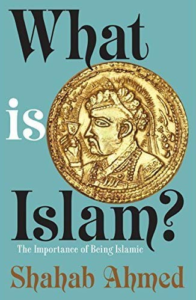
While Ahmed insists that he is “not suggesting in any way that pre-modern Islam is somehow more authentically Islam than is modern Islam,” it’s hard to see how he isn’t doing precisely that, given that he also says that the legalist-textualist focus of modern Islam is “to impoverish and distort the meaning of Islam.” In any case, he clearly favours shifting the emphasis, within modern Islam, from the focus on literal textual authority that characterises fiqh jurisprudence, to what he sees as the wider, richer, older version of Islam in which legalist-textualist approaches had to compete with equally strong currents representing a more autonomous and exploratory approach to the discovery of Islamic truth. Ahmed laments that most attempts at liberal reform within Islam are unduly self-limiting, since they either see themselves as needing to appeal to specifically non-Islamic resources, or else they look for proof-texts of liberalism solely within the pages of Qur’an and Hadith rather than casting their nets more broadly within the wide sea of Islamic-but-non-legalistic discourse.
While the independent truth-claims of Greek-influenced Islamic philosophers like Ibn Sina (Avicenna) and Ibn Rushd (Averroës), often at odds with the literal word of Qur’an and Hadith (on the eternity of the world, for example), are now relatively well-known in the West, some of the other resources Ahmed examines, e.g from painting and poetry, may be less so. Among Ahmed’s many examples of the “confident assertion and widespread social circulation of the self-confident norms of the Sufi-philosophical amalgam posited opposite and above the norms of the law” are the following popular 17th-century Sufi verses:
Law says, “Go to the Mullā and learn the rules and regulations!”
Love says, “A single word is enough: shut and put away all other books!” …
Law says, “Have some shame and decency: put out this light!”
Love says, “What is this veil for? Let the visions be open!”
Law says, “Come into the mosque and perform the obligatory prayer!”
Love says, “Go to the wine-tavern, and having drunk, pe[r]form the super[er]ogatory prayer!” . . .
Law says, “O, Believer! go for Ḥajj – for you will have to cross the Ṣirāt Bridge!”
Love says, “The door of the Beloved is the Kaʿbah, don’t move from there!”
Another example is this bit of political advice from the pen of 17th-century Afghan poet Khwushḥāl Khān:
An Unbeliever … if he is just … is better than a Muslim ruler who rules with injustice. …
Concern yourself with justice … and fair judgement …
not with Unbelief and dīn [= “religion,” “worship”] ….
For it is those that are necessary to preserve the state;
Justice and fair judgement displayed by an Unbeliever
Are better than the injustice of a dīn-observing Ruler! …Nūshirvān was an Unbeliever, but displayed justice in his conduct of affairs, and the Prophet spoke of him with praise.
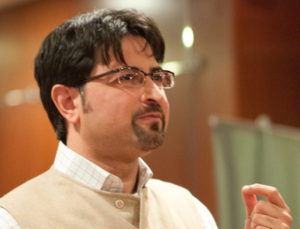
Ahmed also cites the once-common trope of “the devotion of a Muslim lover to a non-Muslim beloved, celebrated in the famous story … by Farīd-ud-Dīn ʿAṭṭār, of the pious Shaykh Sanʿān who fell in love with a Christian girl and became her swineherd” – a particularly shocking profession for a pious Muslim – “which is a very different sort of fiqh al-dhimmah [= the Islamic law of second-class status for non-Muslims]” that might be profitably “mobilized by modern Muslims for the cultivation of pluralism.” (While I can’t be sure, I have a strong suspicion that this reference to the pious Muslim’s becoming a swineherd for his non-Muslim beloved may also be a playful reference on Ahmed’s part to his own marriage; while his widow, Nora Lessersohn, may for all I know be a Muslim too, she’s an American of apparently European ancestry whose academic work focuses on the “historical constitution of non-Muslim identities in the Ottoman Middle East,” so, y’know, I just got the vibe of a private joke from that passage ….)
With regard specifically to wine-drinking, a frequent subject of Islamic poetry and painting – and one that interpreters have often tried to explain away either as being purely symbolic (and so not really about wine-drinking) or else as being purely secular (and so not really Islamic) – Ahmed marshals considerable evidence to show a) that it was literal wine-drinking that was meant, and b) that such wine-drinking was portrayed, in such poems and paintings, as an expression of, rather than something at odds with, Islamic commitment.
Among the questions Ahmed poses are these:
The Dīvān of Ḥāfiẓ was, in the period between the fifteenth and the late-nineteenth centuries, a pervasive poetical, conceptual and lexical presence in the discourse of educated Muslims in the vast geographical region extending from the Balkans through Anatolia, Iran and Central Asia down and across Afghanistan and North India to the Bay of Bengal that was home to the absolute demographic majority of Muslims on the planet. … [W]hen the most widely-copied, widely-circulated, widely-read, widely-memorized, widely-recited, widely-invoked, and widely-proverbialized book of poetry in Islamic history – a book that came to be regarded as configuring and exemplifying ideals of self-conception and modes and mechanisms of self-expression in the largest part of the Islamic world for half-a-millennium – takes as its definitive themes the ambiguous exploration of wine-drinking and (often homo-)erotic love, as well as a disparaging attitude to observant ritual piety, is that canonical work and the ethos it epitomizes Islamic? …
Two of the most socially-pervasive and consequential thought-paradigms in the history of societies of Muslims are the Philosophy of Illumination … of Shihāb al-Dīn al-Suhrawardī … and the Unity of Existence … of the “Akbar-ian” school of the most influential Sufi in history, the Shaykh-I Akbar (Greatest Shaykh), Muḥyi al-Dīn Ibn ʿArabī ….. Both are cross-inflections of (Avicennan) philosophy and of Sufism [that] blur, in their respective emanationist iterations of the relationship between the Divinity and the material world, the boundary between Divine transcendence and Divine immanence, and thereby flirt incorrigibly with pantheism and relativism. Are these Islamic ideas? …
[W]hen Sufis make their culminating assertion that virtuoso “friends of God” … who are at experiential
one-ness with the Real-Truth … are no longer bound by the specific forms and strictures of Islamic law and ritual practice, al-sharīʿah, that confine less spiritually and existentially developed souls, is this an Islamic or an un-Islamic truth-claim?
Ahmed’s answer is that all of these should be counted as authentically Islamic.
As Above, So Below
Ahmed devotes several pages to an analysis of the following 16th-century Iraqi illustration (figurative painting! strike one!) of two wine-parties (alcohol! strike two!), known as “Worldly and Otherworldly Drunkenness,” or “The Angel of Mercy Raised the Cup of the Pleasures of Intimate Company” (the line is from the aforementioned, extremely popular 14th-century Iranian poet Ḥāfiẓ), in which a human drinking party below mirrors and is mirrored in an angelic drinking party above:
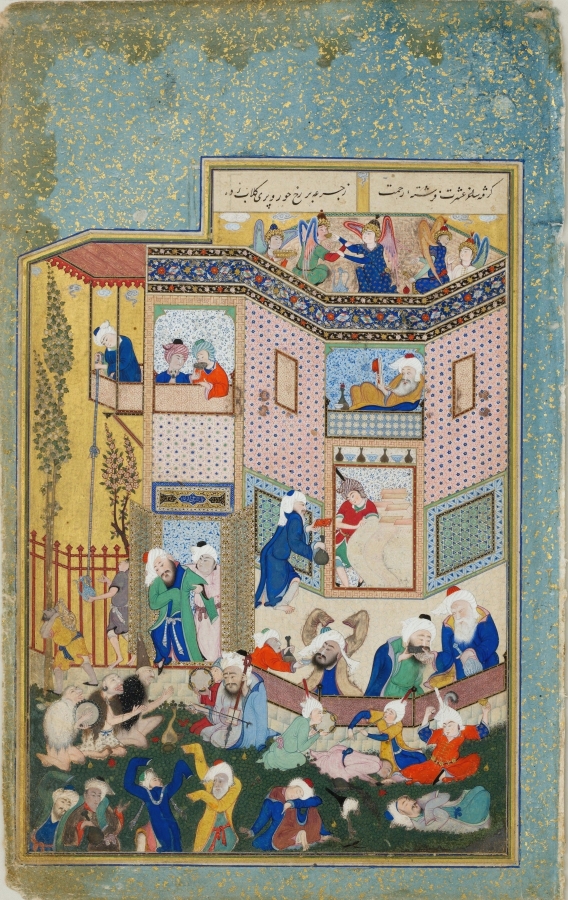
Ahmed interprets the illustration through the lens of Ḥāfiẓ’s poetry:
To state the obvious, the painting presents the denizens of both the Seen and Unseen worlds engaged in the same activity: wine-drinking. … Yet, while the activity of wine-drinking is the same throughout, its function and effect and consequence – that is to say, its meaning for those engaged in the activity – is different at different planes of the spatial hierarchy of the canvas. At the lowest plane, wine is manifest as a medium for social intimacy, uplifting energy and blithe contentment. … At the second plane of the spatial hierarchy of existence, wine is raised up (via a knotted rope) to the level of being a source for meaningful conversation, contemplation and intellection. … The portrayal of the Unseen drinking-party of the angels adds another dimension to the meaning of wine for human beings. … The act of wine-drinking in the Seen World is related and connected to the Other World: in the act, earthly wine-drinkers are entering into that relation and enacting that connection – that meaningful co-relation – of Seen to Unseen, of wine to Wine ….
Wine is a shared medium that links the existences of the Seen and Unseen worlds: to drink wine is to know and experience something of and like the Unseen even as we cannot see the Unseen. The earthly wine-drinkers are entering into a dynamic of upward motion – expressed in the painting in the raised hands of the dancers, the tall and slender trees that blossom as they rise, the two floors of the building with their differently engaged denizens, and, of course, the raising of the wine on the knotted rope (the wine in the painting both goes up itself and takes you up with it). The lower, real, material, everyday wine of the Seen world is, in other words, transporting and transforming the drinkers upwards towards (altered) consciousness, knowledge and experience of the higher, Real, ideal, eternal Wine of the Unseen world. As one’s gaze moves up from the bottom of the painting, one goes from the realm of the material, to that of the intellectual, to that of [the] ideal. Wine is a means to meaning that is diffused throughout the canvas of the cosmos: the same act of meaning-making is taking place on earth and in heaven and in-between ….
To Live Outside the Law, You Must Be Honest
Ahmed uses the terms “Text,” “Pre-Text,” and “Con-Text” to explicate his ideas. The Text is the set of literal prescriptions and proscriptions in the Qur’an and Hadith, while the Pre-Text is the source of deeper reality from which the Text draws and to which it points. Even rigid textualists, Ahmed says, are committed to acknowledging the existence of the Pre-Text, since if the Text is a divine revelation then there must ipso facto be a deeper reality behind it. The dispute between the rigid textualists (as represented traditionally by fiqh jurisprudence, but now fairly prevalent in the Islamic world generally) and the more pluralist traditions that Ahmed champions turns not over the existence of the Pre-Text, nor again over whether the Text represents a legitimate mode of access to the Pre-Text, but rather over whether the Text represents a unique and privileged mode of access to the Pre-Text, or whether other modes of access might be its equal or even its superior. Finally, the Con-Text represents the entire body of self-consciously Islamic beliefs, practices, and traditions – e.g., law, literature, art, spiritual discipline, political administration – on which Muslims draw in order to access the Pre-Text. (Adapting a formulation of Chris Matthew Sciabarra’s, we might say that Ahmed is offering a dialectical approach to Islam, in the sense of an art of Con-Text-keeping; or likewise, with a nod to David Kelley, we might say that Ahmed is championing the idea of Islam as an open system rather than a closed one.) Ahmed’s concern is that for modern Muslims the Con-Text has become so emaciated, by comparison with its former breadth, that Muslims (as well as outside observers, both sympathetic and hostile) have lost the ability to recognise non-Textual approaches to accessing the Pre-Text as genuinely Islamic.
Ahmed is careful to note, however, that the trajectory in modern Islam has not been solely in the direction of greater textualism. Muslim attitudes toward slavery are one case where rigid textualism has been more thoroughly rejected today than was the case in earlier centuries:
For example, when God assumes in the Qur’ān the existence in society of slavery and legislates with slaves in mind – that is, where God accepts slavery as an Islamic legal form – how does it make modern interpretive sense to do what all modern societies of Muslims have done and abolish slavery? The justificatory logic for the abolition of slavery is that the Qur’ān is understood to emphasize the ontological and spiritual (if not the legal) equality of all humans, and … therefore the outright abolition of slavery is seen as a fulfillment of a higher divine/Pre-Textual value and purpose. The counter-arguments, that to abolish slavery is to deny the Muslim his/her apparently God-approved right to own slaves … seem not to have had much purchase in the sensibilities of modern societies of Muslims. Here, a Textual form has successfully been done away with as incompatible with the interests of a presumptive Higher or Pre-Textual meaning.
But as Ahmed adds, this resistance to textualism is quite limited, as, for example, “the logic of applying the same principle – namely, the ontological and spiritual equality of all humans – to the question of the legal and social rights of women has not persuaded the vast majority of the modern practitioners of Islamic law” (though obviously it has persuaded many individual Muslims).
What, in Ahmed’s view, has led to the relatively recent dominance within Islam of a “modern legalist and Textualist” orientation that, in his words, represents, “an act of selective historical memory,” an “unwillingness to admit into evidence such materials from the historical memory projects of Muslims … as were not primarily concerned with authoritative prescription,” including texts that are “often at variance with the contents of Hadith” and “present an image of the community of … Islam that is considerably more complicated and contradictory than is congenial” to the legalist-textualist project?
Ahmed offers several explanations. One is that the success of modern science, by devaluing other modes of knowledge such as philosophical reasoning and Sufi mysticism, has led, perhaps paradoxically, to a strengthening, rather than a weakening, of religious fundamentalism:
[T]he self-demonstrating power of modern science … with its fundamental epistemology of the empiricization of reality – that is, its constitution of the real object of knowledge solely as that which can be empiricized – generated in societies of Muslims (as it did in societies of non-Muslims) a turning-away from the idea of the Unseen World as an accessible object of real knowledge alongside the Seen world, and a turning towards the Seen World as the valid and accessible object of real knowledge. The reaction in societies of Muslims to the “disenchantment of the world” and the empiricization of reality has been not to deny the existence of Unseen/Pre-Text, which is vouchsafed in the Seen/Text of Revelation, but rather to deny the knowability (and thus the actionability) of the Unseen/Pre-Text other than by means of the Seen/Text of Revelation. This position is not new in and of it[s]elf …. What is new and modern … is not the idea that the Pre-Text is unknowable save through the Text, but is rather the fact that this conceptualization of reality has, by force of the encounter with the Western modern, become the dominant conceptualization of Islam in the Islamic modern ….
I’m reminded of one of my favourite passages from Richard Mitchell (the Underground Grammarian), a lament not about Muslim modernity but about modernity generally:
Ambiguity, irony, and wit, to say nothing of deliberate pondering and metaphoric analogy, are not common either in the texts exchanged by managers or in those by which children are taught to “read.” For it is not truly reading that they are taught; it is the receiving of communication. We do this in the strange belief that they ought not to have to suffer perplexity, but it is only as the mind notices its perplexity, and suffers – for the noticing is not by itself enough – that it begins to move from recitation to consideration, to taking some grasp of itself.
Another explanation put forward by Ahmed for the eclipse of Islam’s more philosophical, poetic, and pluralistic heritage in favour of textual literalism is that the comparatively recent imposition on Muslim societies of the alien institution of the nation-state, with its “enormous emphasis on law as the fundamental value-constituent of human society,” has contributed to a cultural atmosphere in which “an enormous definitive and constitutive authority is necessarily vested in legal discourse,” leading to an historically inaccurate perception of Islamic society as such being essentially and always law-centric.
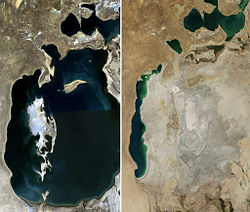
Aral Sea, 1989 vs. 2014
Yet another reason, Ahmed suggests, for the decline in Muslim engagement with the “discourses of the philosophers and the explorative Sufis” is the “loss of language” consequent on “two of the Prime Movers of modernity, colonialism, and nationalism.” In particular, the “loss of Persian as a trans-continental language of the vast complex of discourse and meaning-making of educated Muslims from the Balkans to Bengal, and its reconstitution as what, in historical terms, is a local language of nationalism and nation-state, is probably the single most important factor ….” While at one time, says Ahmed, educated Muslims were familiar with texts in a variety of Islamic languages (e.g., Arabic, Persian, Ottoman, Urdu), nowadays, for example, Persian – the “foundational language” for much of the broader approach to Islam that Ahmed is championing – is “routinely taught in schools only in those nation-states where it is the native/‘national’ language (Iran, Tajikistan, and war-ruined Afghanistan),” and is “simply no longer the language of self-cultivation and written communication of educated Muslims from the Balkans-to-Bengal.” And in those Muslim countries where Persian is taught, e.g. Iran, “the vast corpus of ideas produced in Persian” is read, reductively, as a “perennial narrative myth of Iranian national identity.” Thus the “ideas, attitudes, dispositions, and sensibilities” of Persian-language Islamic literature are “no longer an immediate, accessible and active part” of a worldwide Muslim cultural milieu. In “places where, just a few generations ago,” such texts were “a central component of the paideia that formed selves and that informed the conceptual language and values by which those selves interacted with each other in society,” engagement with this literature has “shrunk like the Aral Sea leaving behind only the dusty traces of its former depth and fertility.”
A final explanation offered by Ahmed appeals to an unfortunate accident of geography: “the rise in a relatively unimportant part of northern Arabia in the eighteenth century of Wahhābism,” a particularly rigid legalist-textualist form of Islam, “followed by the accession to power in the Arabian peninsula by the adherents of this movement in the early twentieth century, followed in turn by the discovery of copious quantities of the most strategically critical and financially lucrative modern commodity in the Arabian peninsula, the funds from which have entrenched the power of the Saʿūdī Wahhābī state and supported the propagation of [its] creed worldwide.”
Noting that “the tendency of modern reformers has been to manoeuvre, to the extent possible, within the parameters … of the Text – that is, to identify Pre-Text through and by the Text,” Ahmed laments that “no modern reformer has attempted to play the philosophical card and to appeal explicitly to the categorical higher Truth-value of Pre-Text as trumping Text” – an approach that, “if successful, would considerably reconfigure the hermeneutical terrain of contemporary Islam.” He recognises, however, that “in the present day-and-age,” where “Muslims’ awareness of their philosophical, Sufi, and larger literary heritage … is a relatively attenuated one,” the “relative unavailability of the Con-Textual thought-tools and norms by which an argument might be made that appeals for its authority to the epistemology of the philosophical-Sufi amalgam” makes such an argument “a very difficult one to produce, and an even harder one to sell.” Nevertheless, Ahmed’s book, it seems to me, offers both a valuable set of tools for reformers within Islam, and a rebuttal to those outside Islam who condemn it as lacking any favourable soil for growths of a liberal and pluralist variety.
But while Ahmed’s sympathies obviously lie with liberal reform, he stresses (with an eye, I suspect, to such matters as the fate of Palestine) that his project “should not be misconstrued as an attempt to present … the ‘soft’ face of Islam,” or a “’turn-the-other-cheek’ Islam, even if it be a rosy cheek”; he has “no interest in peddling an over-irenic picture of Islam,” or in “presenting Islam as in any way compromising a rigorous, principled, combative, and unyielding opposition to injustice and oppression.”
At the time of his sadly early death, Ahmed was working on a sequel to What Is Islam?, intriguingly titled Neither Paradise nor Hellfire: Rethinking Islam through the Ottomans, Rethinking the Ottomans through Islam, which I hope sees posthumous release in some form. (Apparently What Is Islam? began as a brief introductory chapter intended for Neither Paradise nor Hellfire, before growing to a 600-page book. A related work of Ahmed’s, Before Orthodoxy: The Satanic Verses in Early Islam, was released in 2017, two years after his death.)
East Is East and West Is West and Never the Twain Shall Meet?
One disagreement I have with Ahmed is that he seems to slide from the idea of embracing a tradition that includes mutually contradictory perspectives, to the idea of embracing contradictions as such. I’m not sure that’s what he’s saying – the seas of language tend to run a bit high at those points in the book – but if so, then no. As a libertarian, I too embrace a tradition that includes mutually contradictory perspectives (anarchist and minarchist; capitalist and anti-capitalist; utilitarian and natural-rights-based), and I’m ecumenical enough to grant that they all count as libertarian; but I’m not embracing the contradictions themselves.
Another place I’m inclined to disagree with Ahmed is with his denial that Islam is a religion, and thus with his concomitant drawing of the boundaries of Islam so widely that Jewish and Christian writers within the Islamic sphere of influence (e.g. Maimonides) count not just as Islamic-influenced but as Islamic, full stop; that seems to me to be a bridge too far.
Still another disagreement turns on his suggestion that Islam is unlike Christianity in having its traditional sources of spiritual authority diffuse, rather than institutionally concentrated. Here Ahmed approvingly quotes Joachim Matthes:
While Christian “religion” has … its Sitz im Leben … in the church and the local Christian congregations in which it is organized, Islam’s Sitz im Leben is more pronounced in everyday life, in the social and cultural bonds which connect people, in their ways of communicating with one another.

Certainly this description could not apply to present-day Christianity; the number of people in the modern world who self-identify as Christians but do not identify with any particular church institution is famously high. But I maintain that it does not apply to mediæval Christianity either. The authority of the Church to define what was and was not correct Christian doctrine and Christian practice never went unchallenged. Indeed, the existence of the Catholic/Orthodox split is enough to make that clear; but moreover, the whole history of the Church – whether Catholic or Orthodox – from the earliest days through the Renaissance was an endless struggle to suppress the “heresies” (i.e., variant interpretations of Christianity) upheld by Arians, Nestorians, Coptics, Iconoclasts, Sabellians, Donatists, Pelagians, Monothelites, Monophysites, Miaphysites, Henricians, Latin Averroists, Bogomils, Cathars, Fraticelli, Free-spiritists, Waldensians, Hussites, Anabaptists, Socinians, and countless others (some more severe and others more lax than the reigning orthodoxy) – until finally the centrifugal force of the Reformation, in the west, shattered all hopes for securing an ecclesiastical monopoly (while in the east, the Orthodox church for its part has never ceased throwing off refractory splinter groups of its own).
But if Christians have never been united in recognition of a common ecclesiastical authority, have they not at least been united in deference to a particular text, the Bible? Well – but the Bible is not a particular text; unlike, e.g., the Qur’an, it is a collection of a vast variety of different texts by different authors over the course of millennia, and the question of which of these texts should be taken to comprise “the Bible” – both the Old and the New Testaments (to say nothing of the Nag Hammadi texts) – has been a matter of recurring political debate throughout Christian history. (And to this day, Catholics, differing Orthodox sects, and differing Protestant sects are divided as to the precise composition of both the Old and New Testaments – thus rendering the notion of sola scriptura a hopeless kaleidoscope.)
It seems to me, then, that the attitude that Ahmed recommends to Muslims is equally open to Christians – namely, to accept, as a Christian possibility, that some source of moral and spiritual knowledge other than the Bible (e.g., philosophical philosophical reason, personal mystical inspiration, communal customs, etc.) might be superior in authority to the Bible – drawn, in effect, from the same well as the Bible, and importantly akin to it, but drawn from a deeper and purer level (a “Pre-Text,” in Ahmed’s terminology).
No Earthly Church Has Ever Blessed Our Union
A nun is lamenting with unutterable tears and moans,
grieving deeply on behalf of her companions:
Woe is me, nothing is more degrading than such a life!
for, though I am made for love and play …
I have to ring the chapel-bell,
to chant the psalter over and over ….
How gladly I would fly into a lover’s arms! …
Young man, please don’t delay!
I’ll do your bidding; sleep with me!
If you don’t want to, there’s no more to say,
woe is me! and no more to do, wasting my life –
since I can still destroy myself.
(Quoted in Peter Dronke, Medieval Latin and the Rise of European Love-Lyric, vol. 1)
And this brings me to the second of the two allegedly impossible concepts in the above-cited Thomas Bauer quote (“Reference to an ‘Islamic wine goblet’ makes about as much sense as talk of ‘Christian adultery.’”). We’ve seen how Ahmed defends the Islamic wine goblet. What of Christian adultery (and likewise Christian fornication)?
I’ve recently blogged a fair bit about the mediæval courtly-love tradition. (See here, here, here, here, here, and here.) A notable feature of courtly-love literature is that adulterous relationships are often treated as enjoying a Christian sanction.
In Marie de France’s Eliduc, for example, the adulterous lovers, in making their escape, feel no hesitation in calling “upon God, St Nicholas and St Clement, and upon the Virgin Mary to beseech her son to help them” – and indeed they escape successfully.
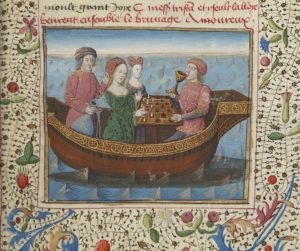
Likewise, throughout Béroul’s version of the Tristan legend, the adulterous lovers seem confident that God is on their side (and Béroul himself seems to concur). Against the (perfectly true) charge of adultery, for example, Tristan proposes to defend himself and Yseut in trial by combat, “so great was his trust in God” that he would succeed therein; and later on, he prays: “God, our true King, I have had many fine shots with bow and arrow; grant me not to miss with this one. … God, who allowed Your Own most holy body to suffer death for your people’s sake, let me avenge myself on these villains” – namely, those who reported Tristan and Yseut’s adultery to her husband, an act for which Béroul condemns the “villains” in propria voce no less indignantly than Tristan does, and cheerfully applauds Tristan’s success in killing them. Likewise, when Tristan and Yseut manage to escape being spied on by Yseut’s husband, Yseut’s maid Brangwen tells her: “God has really worked a miracle for you. He is a true father, and he will not harm those who are loyal and good.”
The view that Tristan and Yseut’s relationship is sinful does get a hearing, in the voice of Friar Ogrin (who nevertheless willingly hides the adulterous pair from her husband’s searching troops), and once the effect of the love-potion diminishes (it doesn’t ever seem to wear off entirely), the lovers are temporarily won over, at least in part, by Ogrin’s arguments; but from what we know of parallel texts (Béroul’s version is incomplete here) they seem to have resumed their relationship shortly afterward nonetheless (see, e.g., “The Madness of Tristan”).
Or, to take a real-life case (though one of fornication rather than adultery), as Stephen Jaeger points out in Ennobling Love , the authors of the early love letters attributed to Abélard and Héloïse “are convinced that their attachment is pleasing to God and never express any uncertainty on that score,” and “seem to think that God agrees with them rather than with tradition in the incorporation of physical pleasure into ennobling love.”
C. S. Lewis complains in his Allegory of Love:
[Lancelot] is represented [by Chrétien de Troyes] as treating Guinevere with saintly, if not divine, honours. When he comes before the bed where she lies he kneels and adores her: as Chrétien explicitly tells us, there is no corseynt [“saint’s body,” i.e, a holy relic] in whom he has greater faith. When he leaves her chamber he makes a genuflexion as if he were before a shrine. The irreligion of the religion of love could hardly go further. Yet Chrétien — whether he is completely unconscious of the paradox, or whether he wishes, clumsily enough, to make some amends for these revolting passages – represents his Lancelot as a pious man and goes out of his way to show him dismounting when he passes a church, and entering to make his prayer; by which, according to Chrétien, he proves both his courtesy and wisdom.
Lewis unsurprisingly fails to consider a third possibility: that Lancelot’s devotion to Guinevere might represent an alternative conception of Christian spirituality.
Some of the troubadours’ songs seem to treat devotion to one’s beloved as, simultaneously, a (legitimate) rival to the love of God and as not truly a rival to it:
Beyond our human nature
God made your excellence
To show by its very essence
That you were born to rule. …
And if I seem a fool
To set you as my queen,
Know that I don’t blaspheme ….
(Guido Cavalcanti, 13th c.; in James J. Wilhelm, ed., Lyrics of the Middle Ages: An Anthology)Shines among the powers of heaven
God the creator, more than Sun in our eye;
Each angel knows the Maker beyond its sphere,
And turning its circle, obeys God’s noble power. …
In the same way, in all truth, the beautiful lady …
In her eyes reflects the desires of a noble man
Who will turn his every thought to her command. …Lady, God will ask me: “Why did you presume?”
When my soul stands before his mighty throne. …
“You passed the heavens, came all the way to me,
And cheapened me in the light of profane love.
To me is due all the praise ….”
I’ll tell him then: “She had an angel look –
A heavenly face.
What harm occurred if my love in her was placed?”
(Guido Guinizelli, 13th c.; ibid.)
And even the pious Dante made his (unconsummated) love for another man’s wife the centerpiece of La Vita Nuova and La Divina Commedia, paying to the sainted Beatrice the kind of reverence ordinarily reserved for the Virgin Mary.
The authors of courtly-love treatises regularly treated adultery and fornication, at their best, either as expressions of Christian virtue or else as minor transgressions of no great seriousness (or, often, both). Just as Arabic love poets wrote that “Love of beauty is a religious duty imposed on every free person / And in flirtation there is an excuse for those who violated chastity” (quoted in Leslie F. Compton, ed., Andalusian Lyrical Poetry and Old Spanish Love Songs: The Muwashshah and Its Kharja), so Richard de Fournival, in his Counsels on Love, writes:
I feel certain that those who listen to what I have to say will feel neither obliged nor able to reproach young persons who love each other, even if their actions should be unfit for public view. For tenderness of years is a sufficient excuse; and even our Lord, according to the scriptures, pays less heed to the transgressions of youth than to all others. … I know of no reason to condemn love, so long as the love of our Lord be not forsworn, nor any ill done too another. Whatever others may say, I hold that a youthful dalliance is a pleasing thing; and I urge you, as does Ovid, to play while you yet have the time. …
I should like to tell you the qualities that hearts must possess if love is to dwell within them. To begin, a lover’s heart must abound in nobility of thought and deed. This nobility is a kind of grace that one finds, perforce, in those possessed of certain excellent qualities, the first of which is humility. As our Lord has said in the Gospel: “He that humbleth himself shall be exalted.”
[M]arried love is like a debt which one must pay, while the love of which I speak is a kind of grace freely bestowed. Although it is a mark of good manners to pay what one owes, still, there is no more delightful love than that born of the gratuitous favor of an artless, ingenuous heart.
(In Norman R. Shapiro, ed., The Comedy of Eros: Medieval French Guides to the Art of Love)
Or again, in an anonymous Anglo-Norman essay On Courtesy, we read:
Love God, as Christians must
All else; and since we speak of love,
Never neglect to love your neighbor:
When harsh his lot and hard his labor,
Offer him all the help you can.
Thus should you serve both God and man.
For loving homage, duly done,
Brings myriad blessings one by one –
Above all, that which man may render
To creatures of the female gender:
God looks with favor, you will find,
On worship paid too womankind!
For women are the very source
Of fame, wealth, valor, joy – perforce,
Of all the best there is ….
(In Shapiro.)
In the same vein, Andreas Capellanus, in his Art of Courtly Love, explains:
I believe … that God cannot be seriously offended by love, for what is done under the compulsion of nature can be made clean by an easy expiation. Besides, it does not seem at all proper to class as a sin the thing from which the highest good in this life takes its origin and without which no man in the world could be considered worthy of praise. Again, one’s neighbor feels no injury from love – that is, he should feel none – because whatever one person asks of another – that is, whatever he should ask – he is bound to suffer freely when another asks it of him.
And Andreas goes on to cite – the Golden Rule.
As Don Monson points out in his book on Andreas, the Art of Courtly Love represents “a major effort to reconcile secular love with Christian morality,” a project encompassing “the affirmation of love as a source of virtue, an attempt to limit sexual activity in love relationships in terms of both the number of partners and the degree of intimacy, and an effort to regulate and codify love on the model of Christian marriage.”
Although fidelity is reconceived as faithfulness to one’s adulterous lover, Andreas defends, on ethical grounds, attempts to break up an existing adulterous relationship in order to initiate a new one. While Andreas’s precepts of love include the provision that “Thou shalt not knowingly strive to break up a correct love affair that someone else is engaged in,” or, slightly restated, that “Love’s mandate says that no one should knowingly subvert a love which has been properly established by anyone else,” he notes that this precept “speaks of people who are properly joined”; since “a woman is not properly joined in love when the character of the man is not as good as that of the woman or when the pure affection of the heart is not equal on both sides,” it follows that “even if I did know surely that you were engaged to another man, and I thought he was not a fit match for you, if I could talk you out of such a match I would not feel that by doing so I was violating Love’s precepts.” (“Engaged” here means “involved in a love affair,” not “engaged to be married.”) While Andreas offers this as a justification for a rival to try to break up an existing adulterous relationship, it would seem to function equally well as a justification for adultery in the first place.
C. S. Lewis, with his usual ambivalence in such matters, acknowledges that the ideals of courtly-love were a kind of image, even an attractive image, of Christian ethics, but rejects the image as an untenable one nevertheless:

[W]hen Andreas talks of the bonum in saeculo he means what he says. He means the really good things, in a human sense, as contrasted with the really bad things: courage and courtesy and generosity, as against baseness. But, rising like a sheer cliff above and behind this humane or secular scale of values, he has another which is not to be reconciled with it, another by whose standard there is very little to choose between the ‘worldly’ good and the ‘worldly’ bad. That very element of parodied or, at least, of imitated religion which we find in the courtly code, and which looks so blasphemous, is rather an expression of the divorce between the two. They are so completely two that analogies naturally arise between them: hence comes a strange reduplication of experience. It is a kind of proportion sum. Love is, in saeculo, as God is, in eternity. Cordis affectio is to the acts of love as charity is to good works. But of course there is for Andreas, in a cool hour, no doubt as to which of the two worlds is the real one, and in this he is typical of the Middle Ages.
When Frauendienst [service to women] succeeds in fusing with religion, as in Dante, unity is restored to the mind, and love can be treated with a solemnity that is whole-hearted. But where it is not so fused, it can never, under the shadow of its tremendous rival, be more than a temporary truancy. It may be solemn, but its solemnity is only for the moment. It may be touching, but it never forgets that there are sorrows and dangers before which those of love must be ready, when the moment comes, to give way. … The authors are all going to repent when the book is over. The Chaplain’s palinode does not stand alone. … We hear the bell clang; and the children, suddenly hushed and grave, and a little frightened, troop back to their master. …
The courtesy of the Troubadours, of Andreas, of Chrétien, was a truancy. Behind the courtly scale of values rose the unappeasable claims of a totally different and irreconcilable world: it was to this truancy and insecurity that the courtly life owed half its wilful beauty and pathos. … The courtly sentiment is, from the outset, an escape, a truancy, alike from vulgar common sense and from the ten commandments. Chrétien, and Guillaume de Lorris, and every one else had always known that Reason was on the other side. Yet the truancy is felt to be, in some flawed and fragile way, a noble thing: the source of every virtue except chastity, the ‘flemer’ of every vice save one.
(Allegory, op. cit.)
Yet not all the courtly-love writers saw such love as a truancy from “the unappeasable claims of a totally different and irreconcilable world,” nor did they all come trooping back in timid submission at the sound of the church bell. Andreas made a palinode, but there’s no such palinode in Marie de France, or in Béroul, or in Fournival – or in the Ystoria Trystan, where Trystan and Esyllt are spared their customary dolourous fate and end up living in adulterous bliss, happily ever after.
In The Heresy of Courtly Love, Alexander Denomy describes courtly love as … well, a heresy:
The lyrics that voice the sentiments of Courtly Love were written by men who were, for the most part, Christians and who had been reared in that faith and in that atmosphere. Aside from a purely surface coloring and the transference of the Christian virtues to the lover, there is little or no trace of Christianity in their love lyrics. When the troubadours do refer to God and to holy things, invariably their references strike us as shocking and irreverent. The conception of love they developed is directly at variance with Christian morality. It is impossible to reconcile the tenets of Courtly Love with the commandments of God, with the Divine Will as interpreted by Saint Paul, with the teaching of Christ and of His Church. From the point of view of the troubadours, however, love, illicit and adulterous at least in aspiration though it may be, is the source of all good and of all virtue, even chastity.
But of course, in order for it to be a heresy (from a Christian point of view), courtly love must represent a variant interpretation of Christianity. (Denomy would presumably not call Buddhism or Shinto a heresy.) And if courtly love indeed represents a variant interpretation of Christianity, then the question arises as to which interpretation is most defensible – and which resources are allowed to have a bearing on that question. In invoking the authority of the “commandments of God,” the “Divine Will as interpreted by Saint Paul,” and the “teaching of Christ and of His Church,” Denomy is making the point that courtly love contradicts the Text. But might it nevertheless be in accord with the Christian Pre-Text?
I Cannot Look Greenly
Let us close by returning to a work that seems to reject the notion of Christian adultery but arguably embraces it: Gawain and the Green Knight. As I’ve noted previously:
An interesting feature of this story is that while the behaviour of the protagonist is decidedly dodgy by conventional Christian standards – he engages in a romantic dalliance (albeit an unconsummated one) with a woman who is not only married, but married to his own host and benefactor, plus he cheats his host by withholding one of the gifts he agreed to exchange (namely the enchanted girdle) – yet it is only the matter of the girdle that is condemned, and that only glancingly; the dalliance itself, as Gawain carefully negotiates it, is treated as an honourable middle way between, on the one hand, the sin of violating the requirements of chastity and hospitality, and on the other hand, the discourtesy of spurning the (not exactly unpleasant) advances of a fair and noble lady. Yet Gawain is not an anti-Christian tale; the hero carries an image of the Virgin Mary on the inside of his shield, and regards his commitment to the courtly ethos as continuous with his Christian duty – another example of the way that the mediæval Church’s claim of sole authority to decide on such matters did not go unchallenged in popular Christian culture.
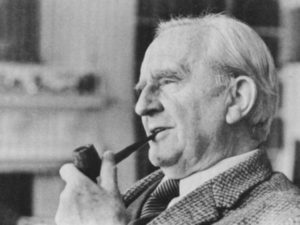
Indeed, Gawain is clearly intended to be a Christian work, as the frequent invocations of Christ and Mary attest. And if, as is generally thought, the author of Gawain is also the author of the very pious (if somewhat creepy) poems Pearl and Purity, then there seems little reason to doubt his sincerity. Indeed, the center of the poem is the fact that, as J. R. R. Tolkien puts it in the introduction to his Gawain translation, Gawain “escapes from a temptation that attacks him in the guise of courtesy through grace obtained by prayer.” In Tolkien’s interpretation, the aim of the poem is to cut the courtly ethic down to size; those aspects that can be reconciled with correct Christian doctrine will be preserved; but those that cannot – such as adultery – are to be discarded. “We see the attempt to preserve the graces of ‘chivalry’ and the courtesies, while wedding them, or by wedding them, to Christian morals [and] marital fidelity”; for Tolkien the poem’s “major point is the rejection of unchastity and adulterous love.” (Gawain introduction; see also Tolkien’s essay on Gawain in The Monsters and the Critics.)
But can a traditional Christian really regard Gawain as so staunchly anti-adultery? It is true that Gawain refrains from actual sexual intercourse with the lady of the castle; but when she comes to his bed, “her noble face and her neck all naked … her breast bare in front and in the back also,” and begins kissing and caressing him, he does not send her away, but instead returns her kisses. Given that traditional Christianity defines adultery rather more broadly than mere intercourse, it’s hard to see how Gawain is not essentially committing adultery, or something comparable to it, with the lady. Aquinas seems rather clear on this:
A lustful look is less than a touch, a caress or a kiss. But according to Matthew 5:28, “Whosoever shall look on a woman to lust after her hath already committed adultery with her in his heart.” Much more therefore are lustful kisses and other like things mortal sins. …
[I]t is a mortal sin not only to consent to the act, but also to the delectation of a mortal sin. … Consequently, when these kisses and caresses are done for this delectation, it follows that they are mortal sins …. Although kisses and touches do not by their very nature hinder the good of the human offspring, they proceed from lust, which is the source of this hindrance: and on this account they are mortally sinful.
(IIaIIæ 154.4)
Now Aquinas might seem to offer Gawain a loophole:
[A] kiss, caress, or touch does not, of its very nature, imply a mortal sin, for it is possible to do such things without lustful pleasure, either as being the custom of one’s country, or on account of some obligation or reasonable cause.
It might be argued, then, that the conventions of courtly behaviour, according to which Gawain would be insulting his hostess by refusing her advances too absolutely, count as the “custom of one’s country, or … some obligation or reasonable cause” that permits his acquiescing in her kisses and caresses (so long as they lead no further), thus exonerating him.
It is true that desire to avoid offending the lady is at least part of his motivation for letting himself be pushed so far toward the line he intends not to cross:
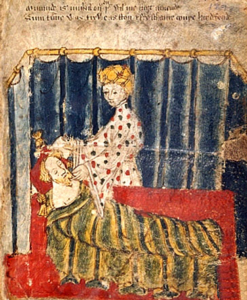
For she, queenly and peerless, pressed him so closely,
led him so near the line, that at last he must needs
either refuse her with offence or her favours there take.
He cared for his courtesy, lest a caitiff he proved,
yet more for his sad case, if he should sin commit
and to the owner of the house, to his host, be a traitor.
But the text makes clear that Gawain is also enjoying the lady’s kisses:
The lady in lovely guise came laughing sweetly,
bent down o’er his dear face, and deftly kissed him ….
so faultless in her features and so fine in her hues
that at once joy up-welling went warm to his heart ….
much pleasure was in that play;
great peril between them stood …
If Gawain is finding a source of “joy up-welling and “much pleasure” in these visits from a beautiful, half-naked, married woman who kisses and caresses him while he lies in his bed, it seems a safe inference that he is lusting after her in his heart – which, by strict Textual standards, is adultery. Yet the poet’s judgment on their interaction is that “no fault could be seen, / nor any evil upon either side.” (And Tolkien, too, seems to agree that Gawain has successfully refrained from the sin of adultery.) The Gawain poet is thus evidently relying on some definition of adultery other than the one laid down by Jesus, and on some criterion of sin other than the one laid down by the Catholic Church.
Law Is the Words in My Priestly Book
The Only Wise One is both unwilling and willing to be called by the name of Zeus.
— Heracleitus
The essential Christian case for adultery, as it might most convincingly be made, would simply be to take the 19th-century case for “free love” (of which, I’ve argued previously, the courtly-love tradition is a partial anticipation) and ground it in the Christian values of love, freedom, and equality.
This does not mean, obviously, that every instance of adultery would count as Christianly justified. It means only that some instances would. Sometimes adultery represents an unconscionable betrayal; sometimes it represents a laudable emancipation from a loveless tie. From a Pre-Textual view, it might seem un-Christian to treat these cases as equivalent.
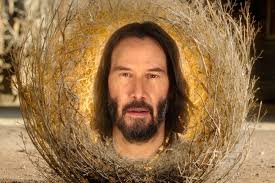
As portrayed in the Gospels, Jesus claims he has come “not come to destroy, but to fulfil” the Law, from which “one jot or one tittle shall in no wise pass.” (Matthew 5:17-18) Yet he is portrayed as dismissing many traditional Biblical laws, including sabbatarian laws (Mark 2:23-27), dietary laws (Mark 7:1-15), and marriage laws (Matthew 19:8). Clearly, the Jesus of the Gospels identified the Law he had come to fulfill with the Pre-Text rather than the Text, regarding the Mosaic, Textual law as only an imperfect reflection of the true, Pre-Textual Law. (“For the hardness of your heart [Moses] wrote you this precept.” – Mark 10:5; cf. Matthew 19:8.)
Why should Christians not take the same attitude toward the decrees of Jesus (e.g., his prohibition of divorce: Matthew 19:9; Mark 10:11-12) as Jesus takes to the Mosaic laws – regarding them as a fallible, imperfect reflection of true, Pre-Textual Law? (Is it because Jesus is God, and so is infallible in a way that Moses wasn’t? Yet as portrayed in the Gospels, Jesus himself, as I’ve argued elsewhere, never claims to be God, but in fact vigorously denies it.)
In short, the courtly-love tradition seems to me to vindicate the idea that what Ahmed says about Islam applies just as much to Christianity (and, I suspect, to any other religion): throughout its 2000-year history, Christians as a whole have never consistently deferred either to the Bible or to ecclesiastical authority to enunciate spiritual truth.

